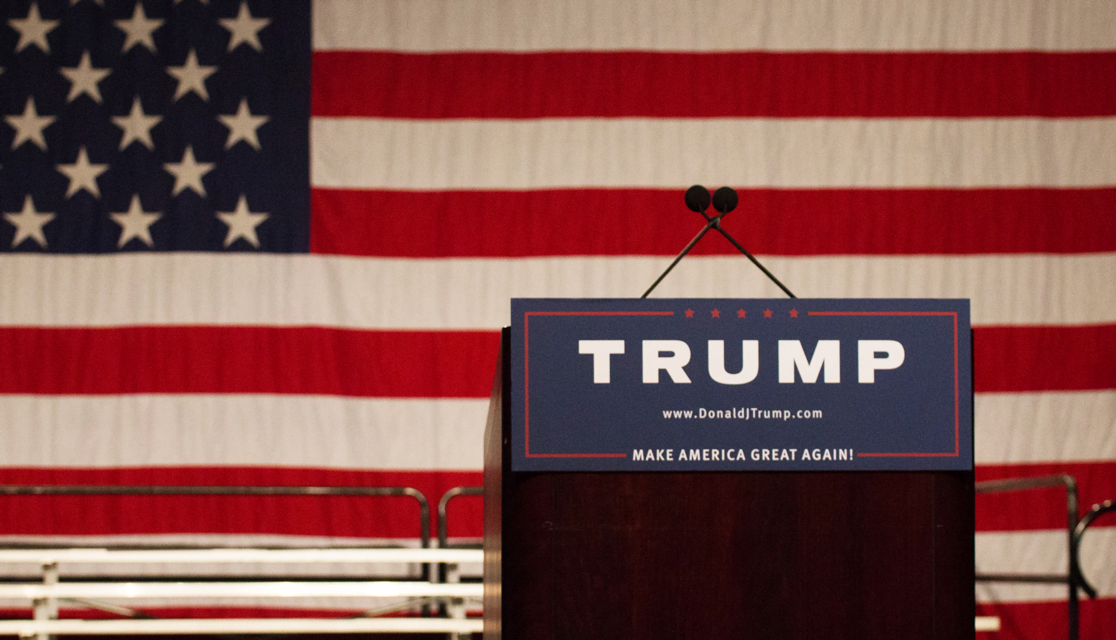Trump’s first campaign rally in Phoenix, Arizona. © Imdan | Dreamstime.com
How will your business fare under the Trump presidency?
- Better. (59%, 369 Votes)
- Worse. (26%, 166 Votes)
- The same. (15%, 95 Votes)
Total Voters: 630
As the dust continues to settle following last week’s national election, pundits now have need to reconsider their visions of the future. First and foremost on the minds of real estate professionals is the question: what does this mean for my local real estate market?
To answer this question, we analyze the different economic factors Trump has promised to alter or act on throughout his campaign. Of course, the days following his election have seen him reverse course on many stances he espoused on the campaign trail, so as you read on, take our analysis with a grain of salt.
First, we start with how his promises impact the broader economy, then narrow our focus to how economic changes will impact the housing market here in California.
Why the market volatility following the election?
Markets crave stability. A Clinton presidency would have represented the status quo, and that’s why markets improved on the eve of the election — everyone expected her to win, so investors were optimistic.
Then, as a Trump win looked more and more likely, the market plunged in the early morning hours of November 9. Standard & Poor’s (S&P) futures fell more than 5% as investors withdrew funds from the more volatile stock market, shifting their funds to less risky standbys like gold.
However, a few hours later — after Trump’s relatively level-headed speech — stocks flattened out as investors decided to take a wait-and-see approach; suddenly, again, the change in the air was not so abrasive.
In the coming weeks, analysts expect the stock market to continue to show volatility as investors attempt to predict how Trump’s policies will impact their business. But what about over the long term?
Is there going to be a recession?
Recessions are inherently bad for housing. Still, despite the hesitancy from markets following the election, we are not on the precipice of an economic recession — yet.
Much depends on how Trump’s trade policies play out.
He has spoken boldly in the past of his intentions to either “renegotiate” or “break” the North American Free Trade Agreement (NAFTA), which regulates trade between the U.S., Mexico and Canada. Doing so will cause a net decrease in economic growth and higher prices on common consumables like gasoline and food, according to Bloomberg.
Trump’s intentions in renegotiating trade partnerships with other countries include returning the focus to U.S. manufacturing. He claims this will create more jobs. But history has taught us clearly that such measures to beef up the domestic product while building walls (sometimes literally) to isolate one nation from global influences inevitably decreases economic growth and increases the prices the now-isolated citizens are forced to pay. For an extreme example of the direction (if not the actual destination) this thinking takes us, consider North Korea.
The chief economist of Citigroup forecasts a Trump presidency will cause our already-timid gross domestic product (GDP) growth to fall by 0.7-0.8 percentage points, bringing the U.S. and global markets closer to recession.
Moody’s Analytics forecasts Trump’s policies — as they stand from his campaign promises — will cause the U.S. to enter a recession a year into his term, in 2018, according to the Washington Post. Think of Herbert Hoover as a parallel presidency.
Whether or not a recession is approaching will depend on how successful Trump is on pushing his dramatic policies through our constitutional system of checks and balances. However, since both the Senate and House are now firmly placed in Republican control, the odds of Trump’s economic agenda — and its consequences — coming to fruition are better.
How will his tax policies impact the economy?
The tax policies put forth during Trump’s campaign include several proposed changes that mainly impact the wealthy, including:
- the repeal of federal estate and gift taxes;
- reducing the corporate tax rate from 35% to 15% (one of the lowest rates in the world); and
- a repeal of the 3.8% healthcare tax on net investment income affecting only those taxpayers with incomes over $200,000 (single filers) or $250,000 (joint filers).
Editor’s note — Trump’s original tax plan called for a 20% ceiling on capital gains. His most recent revised plan leaves capital gains rates as is in the current code, with the exception of the additional 3.8% healthcare surtax he plans to remove with the repeal or revision of the Affordable Care Act.
The Tax Policy Center estimates the top 0.1% of taxpayers (one in one thousand – 1/1000) will receive an average reduction in their tax bill equal to $1.1 million per household under his plan.
However, reduced taxes translate directly into reduced government revenue available to operate government agencies. Trump’s plan will reduce federal revenue by $6.2 trillion over ten years. Further, his plan will increase the national debt by $7 trillion over the same time period, including interest. However, Trump does assure us of un-named spending cuts he will find to reduce this amount.
But do lower taxes for the wealthy, along with all of this lost government revenue, do anything to stimulate the economy?
Over the short term, lower taxes for the wealthy may indeed boost borrowing, the Economist explains. But the same action is likely to increase interest rates — something Trump has stated will be beneficial for the economy — but will ultimately stymie economic growth.
The Tax Policy Center estimates GDP growth will be harmed by higher interest rates brought about by Trump’s plan. The bond market already has a “Trump Jump” in place with rates up significantly reminiscent of the 2013 “taper tantrum” following the Fed’s announcement to end the pumping of money into the banking system. Further, the Fed has promised they will now bump up the short-term rate in anticipation of inflation they expect under fiscal management to come.
What will happen in the jobs market?
Jobs are integral to a healthy housing market. Without jobs, homeowners and tenants are unable to make housing payments, and tenants can’t save to become homebuyers. In turn, home values suffer. The volume of real estate fees slow or become insufficient to non-existent for agents and brokers, as occurred following the 2007 housing bust. Therefore, job growth is a top priority for housing professionals (and anyone who owns or lives in a housing unit).
Trump’s campaign promise to “bring back jobs” was perhaps his most compelling argument for his more rural and economically depressed supporters. But what are his methods to successfully do so?
He claims his jobs plan will create 18 million additional jobs over ten years, on top of what is expected due to population growth. He says he will do this by increasing GDP growth by 1.5% per year to an average 3.5% GDP growth, which he says will create an additional 1.5 million jobs each year.
But, as the New York Times points out, his math doesn’t add up, even if he’s able to stoke GDP growth to 3.5% (unlikely, as presidents don’t have that sort of power). Demographically, there simply aren’t enough adults prepared to enter the labor force — especially if he deports the undocumented labor force and slows legal immigration into the nation needed to support our economy as we now know it. While the labor force participate (LFP) rate includes all working-age adults, many of these adults won’t be able to enter the labor force, as they are students, are disabled, retired, etc. Even at the maximum LFP rate experienced in history, we still fall far short of attaining anywhere near the 18 million additional jobs he calls for without more immigrants from other nations.
Worse, his restrictive trade policies are likely to actually shrink GDP growth for lack of ability to compete by exporting, decreasing the number of jobs available. [See above]
The Peterson Institute projects a loss of 4 million jobs due to Trump’s trade policies, when enacted, according to MarketWatch.
However, he has also promised to rebuild infrastructure, a la Eisenhower, and promises this will create millions of jobs. If indeed his fiscal approach to stimulate the economy is successful, more jobs may be created — just not to the impossible tune of 18 million. Further, his Republican colleagues in the House and Senate are “austerity bound” and unlikely to support such a stimulus program, according to Politico. But you need to suspect they will permit the stimulus, together with a reduction in top tax rates and a massive increase in national debt to avoid that Hoover-induced recession in 2018-2019.
An increase in defense spending is also on Trump’s bucket list, which will greatly benefit California, home to 13% of the nation’s active military. Contractors that work closely with the military like Raytheon and Lockheed Martin, both with offices in California, saw their stocks climb following Trump’s election. Still, Trump unlike Reagan is likely to run into congressional problems coming up with the funds to ramp up defense spending, and his current plan of eliminating wasteful Pentagon spending to come up with the billions of dollars needed to meet his goals has experts scratching their heads.
The big upside for California is, while it may see some of the benefits from federal spending on infrastructure, it is also still a Democratic-controlled state with a gargantuan economy on an independent roll in our global economy. Therefore, it will be able to push off most of the other reforms Trump proposes that will decrease the labor force.
Is he going to repeal Dodd-Frank?
The Dodd-Frank Wall Street Reform and Consumer Protection Act (Dodd-Frank) has made several significant changes to how real estate professionals do business in today’s post-Millennium Boom market. The most visible of these changes has been to regulate the mortgage lending sector from local loan brokers and appraisers to national lenders and credit agencies.
During Trump’s campaign, he expressed a wish to “dismantle” Dodd-Frank. In the days since he’s been elected, he’s confirmed his commitment to pull back Dodd-Frank, but his transition team indicates this may actually look less like a full repeal and more like numerous changes to make Dodd-Frank less restrictive for mortgage products. In the meantime, Trump and others have called for a cessation of any new regulation, according to HousingWire. Californians went through this situation in the 1990s under Governor Wilson, including deregulation.
For instance, Trump can and will replace Obama’s appointees of the watchdog agencies created by Dodd-Frank, including Richard Cordray’s oversight of the Consumer Financial Protection Bureau (CFPB) — if he doesn’t do away with the Bureau altogether.
The CFPB’s purpose is to inform and empower consumers to make healthy financial decisions. It also takes aggressive enforcement actions against companies that act in deceptive or abusive ways against consumers. Since its inception in 2011, it has:
- translated a number of mortgage and other financial forms into plain language for ease of use by the borrowing public;
- collected and responded to consumer complaints;
- filed dozens of lawsuits against financial companies which have harmed or intimidated consumers;
- implemented and enforced new federal consumer financial laws, including most recently an overhaul of the Uniform Residential Loan Application (URLA); and
- implemented changes under the Truth in Lending Act (TILA).
Replacing the current leadership at the CFPB will likely undo much of the regulatory progress the Bureau has made in the last few years. A Republican appointee will certainly act to deregulate CFPB rules, which means fewer lawsuits and consumer protection laws. The potential will increase for a return to the over-lending of the Millennium Boom, a deceptive environment which caused tenants to over-extend themselves as homebuyers, directly contributing to the 2008 Great Recession from which we have not yet fully recovered.
Will he replace the Federal Reserve chair?
Trump believes interest rates are currently too low, blaming Fed chair Janet Yellen. He also stated in his campaign he would likely replace her upon entering office, probably unknowing at the time that Fed chairs are granted four-year terms and Yellen’s isn’t up until February 2018.
The only way to fire a Fed chair prior to the expiration of their term is to find “cause” to do so. A disagreement between the president and the Fed chair’s policies do not constitute cause, according to the Financial Times.
However, the potential replacements he’s named for Yellen’s spot, when it opens in 2018, are likely to stick with the “hawkishness” (read: more concerned with over-inflation than a lack of economic growth, thereby inclined to increase interest rates) of Republicans, meaning higher interest rates are likely no matter what Trump wants.
What will happen with interest rates?
Like the stock market, interest rates have also shown volatility since the election.
Fixed rate mortgage (FRM) rates are inextricably tied to the 10-year Treasury Note (T-Note) rate. Typically, the average 30-year FRM rate moves in tandem with the 10-year T-Note rate at a spread of about 1.5%, which represents the hedge against the higher risk of default present in home mortgages than treasuries. But when bond market investors are uncertain about future economic conditions, they pad their spread against a higher default risk. That’s why the spread between the two rates (bond rate and mortgage rate) has remained elevated throughout 2016, and will likely continue to remain high — which means higher mortgage rates for homebuyers and refinancers, as well as higher lender profits.
Trump’s election caused many bond market investors to dump their 10-year T-Notes. When investor demand for T-Notes falls, the interest rate rises which directly results in higher mortgage rates. For example, demand for T-Notes has been high during 2015-2016, as very few safe investments are left in the global economy following nativist shocks like the United Kingdom’s “Brexit” from the European Union and the general economic crises in both Asia and South America.
However, that relative safety was threatened by the policy uncertainties of a Trump presidency and investors abandoned the 10-year T-Note quickly, causing it to rise from 1.83% on November 7, the day before the election, to 2.07% the day after the election, the biggest jump since 2013’s taper tantrum.
Since FRM rates are tied to the 10-year T-Note rate, FRM rates also jumped following the election.
In California, the average 30-year FRM rate rose from 3.49% at the start of election week to 3.73% by the end of the week (and climbing), according to Bankrate, the largest jump experienced over the past year by far. That jump certainly killed deals contingent on purchase-assist mortgage financing. For perspective, this 0.24 percentage point increase represents a loss of about $11,000 in mortgage principal available to the California homebuyer with an average household income. The loss in buyer purchasing power is even worse across the nation, where average mortgage rates have risen even higher following the election news.
This is clearly bad news for buyers, who suddenly find themselves able to qualify for less home, but it’s also bad for sellers who rely on buyer’s access to sufficient mortgage credit to sell. Whatever Republican “hawk” Trump appoints to replace Yellen in 2018 will cause interest rates to increase further.
The future of housing
Trump’s top experience prior to his foray into reality television and politics was as a real estate mogul. However, rather than making him an authority on the housing market, his experience in the luxury real estate market gives him a narrow view of the nation’s housing needs. His experience falls short of what is needed to cultivate a housing plan for all of our nation’s residents, particularly low- and middle-income households who will need some government assistance to maintain the American Standard of Living we all now understand.
For instance, Trump has indicated he will defund or rescind many of the Department of Housing and Urban Development’s (HUD’s) low-income and fair housing programs, according to the National Low Income Housing Coalition (part of the way he will pay for his tax breaks to the top one in one thousand (that 0.1%) earners in our society.
In California, an economically mature state, expect to see more hesitancy from homebuyers in the coming months. Homebuyers are well aware of the economic uncertainty portrayed by their more progressive news sources. On the other hand, agents working in California’s conservative enclaves (e.g. Orange County) might see more clients willing to buy following the Trump win since they have undying confidence in his economic policies.
Trulia suggests the net result of shifting homebuyer confidence will determine home values across the board. For instance, since California’s population has a higher level of education and a willingness to accept change where few adults voted for Trump, California’s net homebuyer confidence is likely to dwindle, following the optimism experienced in the third quarter (Q3) of 2016. Therefore, we can expect a dip in home prices in the coming months (as had been expected anyway). This dip will be worsened once the sustained interest rate rise occurs.
This dip in sentiment may be somewhat counteracted by Trump’s promised spending, which may create more California jobs — if he can secure the funds while simultaneously cutting taxes and renegotiating trade deals. At this point, time will tell whether he will succeed.
The takeaway for real estate brokers and agents? Today is the time to save your fees and work extra diligently to find and advise clients, because a slowing California real estate market is now more likely over the next couple of years. Would-be homebuyers will be put off by rising home prices, lower buyer purchasing power and post-election uncertainty. Then, the economy is likely to continue to slow as Trump’s trade policies are enacted, jobs are lost and higher interest rates follow.
Patience, and an intellectually close observance of actual congressional activity and the slow evolution of its consequences will be the heart of discerning your future for the next four years. Stay tuned to first tuesday, as the ride will be full of surprises, a la Trump.















Obviously this “author” was not a Trump supporter. This “article” is written very biased toward an anti Trump Presidency. I’m so sick and tired (along with 50% of America) of reading or watching editorial “news” when it is suppose to be UNBIASED!!! This is to the author and all the low payed progressive “if it feels good do it” thinkers out there… Do your job and keep your personal opinions to yourself. I for one, have a list of writers, actors and new agencies who have stepped out of line and enjected their personal opinion were it was never asked. Congrats to Ms. Reyes, you made the list of never again waiste my time reading or watching your work.
Ms Reyes has done “her job” admirably. While I’d not defend anyone against ever making an error, First Tuesday has demonstrated a long history of clear-eyed ACCURATE reporting.
What’s ACCURACY got to do with it?
TV viewers have been trained to repeat a fashionable idea that news be “unbiased” and “fair and balanced.” That’s cover for “gimme opinions I already believe.” Rupert Murdoch rightly knew this to be a profitable stance. He made a business from it at Fox “Faux” News creating the idea that news be “fair and balanced.” Faux’s viewers swallowed it, not realizing what they were giving up.
Christiane Amanpour, foreign correspondent with ABC and CNN recently said that, “…“I believe in being truthful, not neutral. And I believe we must stop banalizing the truth.” News needs to be accurate, if it is to serve the truth.
Any “unbiased” observer seeking ACCURACY will notice that no news is without opinion. Anyone who claims otherwise is a faker.
Was there inaccuracy in Ms. Reyes’ reporting? No one has identified any such thing. Instead, many expressed their dislike to read anything that didn’t agree with what they already believe. They’re not looking for “unbiased” news, they’re looking for a gang of thoughts to bolster their beliefs like any lynch mob.
Ms. Reyes reported on, amongst others, the opinions and facts published by Bloomberg News, Washington Press, Standard and Poors, and HousingWire Magazine. Once in the past I disagreed with her column, said so and why specifically. On this column, she has done an accurate job. FT is lucky to have her.
I laughed OUT LOUD over “Denny” and his November-15th lament and nasty others deriding “liberal bias.” Talk about backhauling political commentary into Ms Reyes’ column. Whooo—hoo! Neither liberal or conservative operations have benefitted America. They’re both looking at the world through narrow keyholes from their self-imposed prison cells.
Only those who have gobbled down too much candy would believe they could exist in the real estate industry without eating, breathing, and living in the morass of politics that impinge on us every day. Politics, Denny, are already infused in our profession.
Damning any analyst, like Ms Reyes, that she ignore political climates so readers can have more NAR-style pablum instead of real commentary, would be like asking for more candy.
More will be revealed as history rolls out another four years. In 2020 we can gauge reality next to Ms. Reyes insights. Not now.
Either show a little respect for Carrie. Reyes or let us hear YOUR DETAILED analysis….we’d all like hearing what your projections are, but unlikely you’re as brave as she to put your thoughts on the line in writing.
Geez another liberal anti Trump article, she only quoted anti Trump groups like the NY Times, bloomberg etc. are there any actual reporters that understand economics, oh what, no economics is no longer required in our colleges, actually now that I think about it, college isn’t required to be a reporter either.
I so agree! I am just getting into this business and I was appalled by this article. I was going to cancel my emails until I read all of your level headed comments. Love the cry baby one!!
Amen to the comments; I almost quit reading to the end. Let’s park the status quo mentality that got us to where we are today and let a business savvy President give it a try. Time will tell, but I for one am very optimistic that getting away from where we have been for the past several years can lead to very good things.
I am a mortgage lender. I agree with the replies to date regarding real estate, mortgages, and Dodd Frank; my experience and outlook; I was initially optimistic (yet cautiously anytime government is involved) when information came out that there would be changes that would protect the mortgage consumer from the fraudulent acts of many companies and persons employed in the mortgage industry. I have seen what unscrupulous mortgage companies and individual loan officers and personnel were doing to clients. But, like most things handled by government the pendulum swung out of control. And the costs of a mortgage has increased substantially (some benefit to our clients) as a result of so many unnecessary regulations and compliance issues. So I say, don’t do away with it, but dissect it; figure out what is really a benefit to consumers and delete the rest; truly study the effect of those changes and revise again if and when necessary and without unnecessary delay.